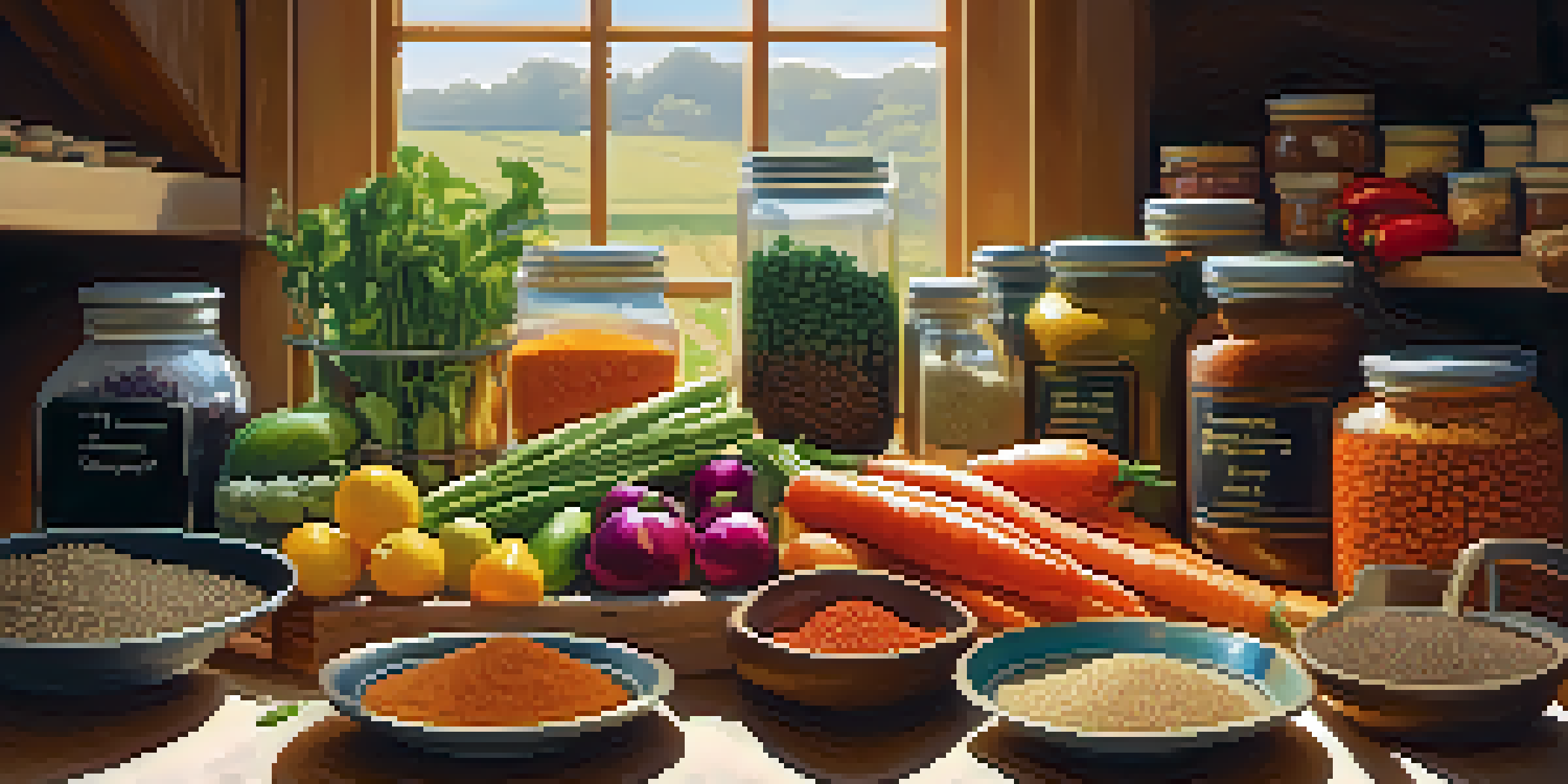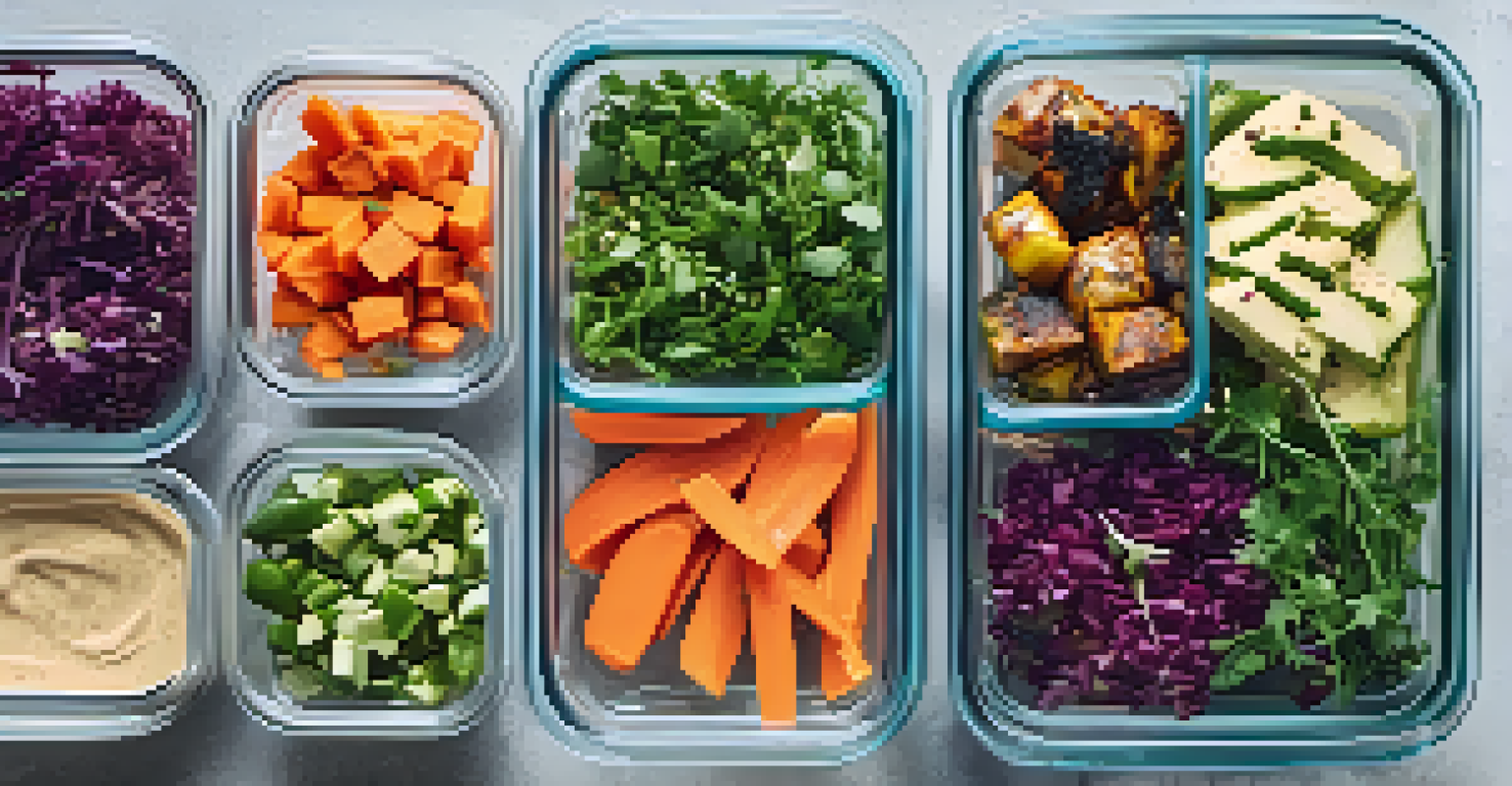How to Meal Prep for a Week of Vegan Meals on a Budget

Understanding the Basics of Vegan Meal Prep
Meal prepping is all about planning your meals ahead of time, which can save you both money and time during the week. For those following a vegan diet, this means preparing plant-based meals that are nutritious and satisfying. Think of it as creating your own ready-to-eat meals that cater to your health goals and budget.
Failing to prepare is preparing to fail.
When you meal prep, you can buy ingredients in bulk, which often reduces costs. Plus, having meals ready to go can help you avoid the temptation of ordering takeout or snacking on unhealthy options. It's about making intentional choices that align with your lifestyle and financial goals.
By understanding the basics of meal prep, you can set the stage for a successful week ahead. You'll be able to enjoy delicious, homemade meals while reducing stress around cooking and grocery shopping.
Crafting a Budget-Friendly Vegan Grocery List
Creating a grocery list is one of the most important steps in meal prep. Focus on staple ingredients like grains, legumes, and seasonal vegetables, which are not only affordable but also versatile. For example, beans and lentils are excellent sources of protein and can be used in various dishes throughout the week.

Don't forget to check your pantry before shopping! You might already have some essentials like rice, pasta, or canned tomatoes that can help you save money. Organizing your list according to the layout of your grocery store can also streamline your shopping experience and prevent impulse buys.
Plan Your Vegan Meals in Advance
Meal prepping helps you save time and money while ensuring you have nutritious, satisfying meals ready to go.
Finally, consider shopping at local markets or discount stores for fresh produce. Buying fruits and vegetables in season can significantly lower costs while ensuring you're getting the freshest ingredients for your meals.
Choosing Versatile Ingredients for Your Meals
Selecting versatile ingredients is key to a successful meal prep. Items like quinoa, brown rice, and sweet potatoes can serve as a base for various dishes, allowing you to mix and match throughout the week. This way, you won’t get bored of eating the same thing every day.
The food you eat can be either the safest and most powerful form of medicine or the slowest form of poison.
Another great option is to incorporate a variety of beans and lentils. These not only provide protein but can also be seasoned in different ways to keep your meals exciting. For example, chickpeas can be roasted for a crunchy snack or blended into hummus for a tasty dip.
Lastly, don’t underestimate the power of herbs and spices. They can transform a simple dish into something extraordinary, enhancing the flavors without additional costs. A little creativity goes a long way in making your meals both delicious and budget-friendly.
Preparing Your Meals: Step-by-Step Guide
Once you have your ingredients, it’s time to get cooking! Start by washing and chopping your vegetables, then cook your grains and proteins according to their respective instructions. It’s helpful to have a few pots and pans ready to go so you can multitask and save time.
Consider batch cooking: this means making larger quantities of staples like rice or beans, which can be used in multiple meals. For example, prepare a large pot of chili that can be served over rice one day and in a wrap the next. This not only saves you time but also helps reduce food waste.
Create a Budget-Friendly Grocery List
Focusing on staple ingredients and seasonal produce can help you build a versatile and affordable grocery list for meal prep.
After cooking, portion out your meals into containers for easy grab-and-go options. Label the containers with the name of the dish and the date it was made to keep everything organized in your fridge.
Storing Your Meal Prep for Freshness
Proper storage is crucial to maintaining the freshness of your prepped meals. Invest in high-quality, airtight containers that are microwave and freezer-safe. Glass containers are a great option as they don’t retain odors and can be reused for years.
Be mindful of how long meals can be stored in the fridge. Most cooked dishes can last about 4-5 days, while others can be frozen for longer periods. If you know you won’t finish a meal in time, freezing it is a smart way to preserve it for later enjoyment.
Additionally, consider grouping similar meals together to make it easier to grab what you want during the week. This organization can save you time and help you stick to your meal plan.
Incorporating Snacks into Your Meal Prep
Don’t forget about snacks! Preparing healthy snacks in advance can help curb hunger between meals and keep you on track with your dietary goals. Think of options like cut-up fruits and vegetables, hummus, or energy balls made from oats and nut butter.
Having snacks readily available can also prevent you from reaching for unhealthy options when cravings hit. For instance, you can prepare a batch of mixed nuts or roasted chickpeas to keep on hand for a quick, satisfying bite.
Store Meals for Maximum Freshness
Using high-quality, airtight containers and organizing your meals can maintain freshness and make it easy to grab meals throughout the week.
Additionally, consider portioning your snacks into small bags or containers. This makes it easy to grab a healthy option when you’re on the go or in need of a quick pick-me-up.
Adjusting Meal Prep Based on Your Lifestyle
Everyone’s lifestyle is different, and your meal prep should reflect that. If you have a busy week ahead, consider prepping simpler meals that require less time to cook. On the other hand, if you have more time, feel free to experiment with new recipes and ingredients.
It's also important to listen to your body and adjust portion sizes and meal frequency as needed. Some days, you might need more food, while others may require less. Flexibility in your meal prep will help you stay satisfied and energized.

Lastly, remember that meal prep can be a fun and creative process. Don't hesitate to try new recipes or swap out ingredients based on what you enjoy. Keeping things fresh will make your vegan meal prep something you look forward to each week.